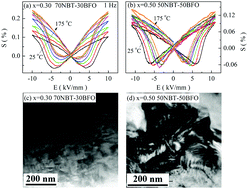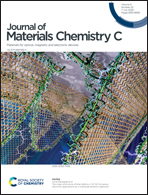Compositionally driven relaxor to ferroelectric crossover in (1 − x)Na0.5Bi0.5TiO3–xBiFeO3 (0 ≤ x ≤ 0.60)†
Abstract
Na0.5Bi0.5TiO3-based materials have been widely investigated over the past two decades due to their giant strain and stable mechanical quality factor, which render them potential alternatives to lead-based materials. One of the limiting factors of these materials has been the relatively lower depolarization temperatures, which restrict their use in high power ultrasonics. This work explores the phase evolution and electromechanical properties of (1 − x)Na0.5Bi0.5TiO3–xBiFeO3 (x = 0–0.60, labelled as NBT–100xBFO) and demonstrates a composition-induced relaxor-to-ferroelectric crossover. With increasing BFO content, the samples exhibit R3c symmetry and the unit cell volume increases monotonously. The electromechanical properties indicate a criticality at x = 0.30, beyond which, NBT–100xBFO becomes ferroelectric. The unit cell distortions reflect the changes observed in the electrical response. These results are further corroborated by the temperature dependent strain-field hysteresis and lamellar domain structure in the TEM images of unpoled NBT–50BFO, indicating a stable, long-range ferroelectric order. The outcome of this study indicates that NBT–100xBFO could be a potential high temperature ferroelectric, which can be further tailored to surpass the existing temperature limits of the NBT class of materials.



 Please wait while we load your content...
Please wait while we load your content...